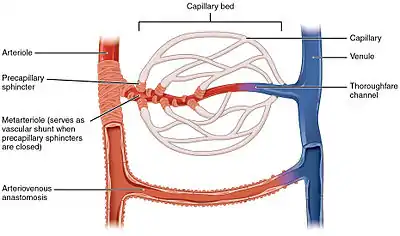Precapillary sphincter
A precapillary sphincter is a band of contractile mural cells either classified as smooth muscle or pericytes that adjusts blood flow into capillaries. They were originally described in the mesenteric microcirculation, and were thought to only reside there.[1][2] At the point where each of the capillaries originates from an arteriole, contractile mural cells encircle the capillary. This is called the precapillary sphincter. The precapillary sphincter has now also been found in the brain, where it regulates blood flow to the capillary bed.[3] The sphincter can open and close the entrance to the capillary, by which contraction causes blood flow in a capillary to change as vasomotion occurs.[4] In some tissues, the entire capillary bed may be bypassed by blood flow through arteriovenous anastomoses or through preferential flow through metarterioles.[2] If the sphincter is damaged or cannot contract, blood can flow into the capillary bed at high pressures. When capillary pressures are high (as per gravity, etc.), fluid passes out of the capillaries into the interstitial space, and edema or fluid swelling is the result.
| Precapillary sphincter | |
|---|---|
 Illustration of a capillary system with precapillary sphincters | |
| Anatomical terminology |
Dispute over concept
Precapillary sphincters and metarterioles were discovered in the mesenteric circulation in the 1950s. Medical and physiological textbooks, such as Guyton, Boron and Fulton, etc. were quick to claim the existence of said sphincters and metarterioles all over the body, despite lack of evidence.[2] At least since 1976 there has been considerable debate about the existence of precapillary sphincters and metarterioles.[5] In 2020, precapillary sphincters were identified as a mechanism for controlling cerebral blood flow.[6]
References
- Precapillary Sphincter definition. The Free Dictionary by Farlex. Medical Dictionary
- Sakai T, Hosoyamada Y (September 2013). "Are the precapillary sphincters and metarterioles universal components of the microcirculation? An historical review". The Journal of Physiological Sciences. 63 (5): 319–31. doi:10.1007/s12576-013-0274-7. PMC 3751330. PMID 23824465.
- Grubb S, Cai C, Hald BO, Khennouf L, Murmu RP, Jensen AG, et al. (January 2020). "Precapillary sphincters maintain perfusion in the cerebral cortex". Nature Communications. 11 (1): 395. Bibcode:2020NatCo..11..395G. doi:10.1038/s41467-020-14330-z. PMC 6971292. PMID 31959752.
- "Autoregulation and Capillary Dynamics" (PDF). Autoregulation and Capillary DynamicsPearson Education Inc., publishing as Benjamin Cummings
- Wiedeman MP, Tuma RF, Mayrovitz HN (July 1976). "Defining the precapillary sphincter". Microvascular Research. 12 (1): 71–5. doi:10.1016/0026-2862(76)90008-x. PMID 967027.
- Grubb, Søren; Cai, Changsi; Hald, Bjørn O.; Khennouf, Lila; Murmu, Reena Prity; Jensen, Aske G. K.; Fordsmann, Jonas; Zambach, Stefan; Lauritzen, Martin (2020-01-20). "Precapillary sphincters maintain perfusion in the cerebral cortex". Nature Communications. 11 (1): 395. Bibcode:2020NatCo..11..395G. doi:10.1038/s41467-020-14330-z. ISSN 2041-1723. PMC 6971292. PMID 31959752.
Further reading
- Baez S, Feldman SM, Gootman PM (July 1977). "Central neural influence on precapillary microvessels and sphincter". The American Journal of Physiology. 233 (1): H141-7. doi:10.1152/ajpheart.1977.233.1.H141. PMID 141891.